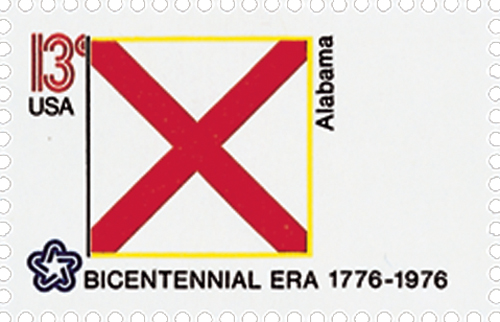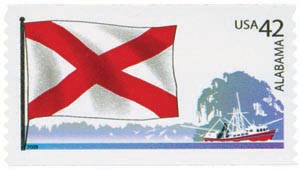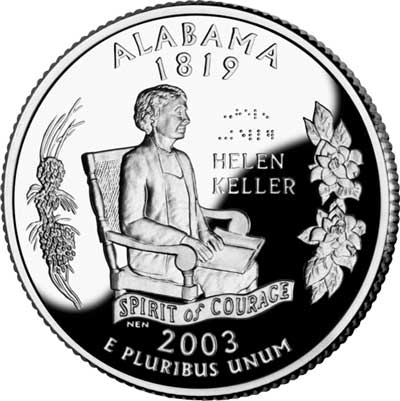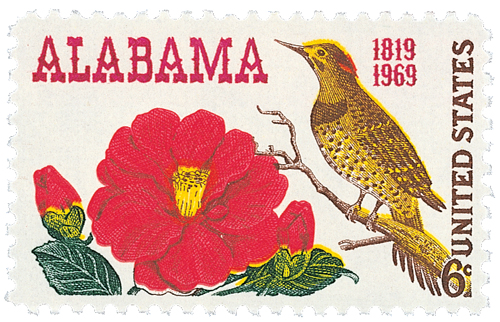
# 1953 - 1982 20c State Birds and Flowers: Alabama
20¢ Alabama
State Birds and Flowers
City: Washington, DC and state capitals
Quantity: 13,339,000 panes
Printed By: Bureau of Engraving and Printing
Printing Method: Photogravure
Perforations: 10.5 x 11.25
Color: Multicolored
Alabama Becomes 22nd State
As far back as 8,000 years ago, American Indian groups lived in the area that is now Alabama. Much later, Cherokee, Creek, Choctaw, and Chickasaw Indians moved into the region. After white settlers arrived in the area, they referred to these Indians as the “Civilized Tribes,” as they adopted many European customs.
The Spanish explorer Alonso Ãlvarez de Piñeda reached Mobile Bay in 1519. Hernando de Soto, also a Spaniard, led an expedition into Alabama in 1540, making him the first European to explore the interior of the region. In 1559, Tristán de Luna ventured into Alabama searching for gold. He organized settlements around Mobile Bay and near today’s Claiborne, but these were soon abandoned after De Luna was relieved of his command and had to return to Mexico.
In 1699, a group of Frenchmen and French-Canadians sailed to Dauphin Island in Mobile Bay. They founded Fort Louis along the Mobile River in 1702. Later, Fort Louis became the capital of the French colony of Louisiana. Flooding in 1711 forced Fort Louis to be relocated 27 miles south, to the current location of Mobile. This became the first permanent white settlement in Alabama. Renamed Fort Condé in 1720, the settlement remained the capital of French Louisiana until 1722, when New Orleans took its place.

In 1763, the French gave up most of the colony of Louisiana to the British in the Treaty of Paris, which concluded the French and Indian War. The Spanish declared war on Britain in 1779. Bernardo Gálvez captured Mobile in 1780. The 1783 Treaty of Paris gave the Mobile area back to Spain.
Thomas Pickney of the U.S. negotiated the Treaty of San Lorenzo in 1795. This treaty fixed the U.S. border along the 31st parallel of north latitude, which meant all of Alabama, except the Mobile area, was part of the U.S. This area was made part of the Mississippi Territory in 1798. During the War of 1812, the U.S. seized the Mobile area from Spain. In 1813, Creek Indians massacred several hundred pioneers at Fort Mims, near today’s Timsaw.
William Weatherford, also known as Chief Red Eagle, who was of mixed European and Native American ancestry, led the Creek. U.S. forces under General Andrew Jackson defeated the Creek in the Battle of Horseshoe Bend in 1814. In 1817, the Alabama Territory was organized. Saint Stephens became the capital city.

In 1819, a convention was held in Huntsville. This convention produced the territory’s first constitution. On December 14, 1819, Alabama entered the Union as the 22nd state. Huntsville served as the capital city, but a little more than a year later it was moved to Cahaba. The capital was moved to Tuscaloosa in 1826, due to extensive flood damage in Cahaba, and finally Montgomery in 1846.
In 1838, U.S. troops marched into the remaining territories in Alabama that were controlled by American Indians. The Indians were forced to move west of the Mississippi River. By 1840, only a few scattered tribes remained in the entire state.
Alabama’s economy suffered many economic setbacks from the 1840s until the Civil War. A state bank had been created during the 1820s. Poorly managed, the bank soon ran into trouble. During the 1840s, Governor Benjamin Fitzpatrick began closing the bank. Many Alabamians lost all their savings. Drought and an outbreak of yellow fever also caused economic difficulties for residents of Alabama.

In the years leading up to the American Civil War, Alabama established itself as a leader in the fight to preserve the right of states to protect slavery. In 1848, the state government adopted the “Alabama Platform,” which declared the U.S. government did not have the right to bar slaves from new territories. Disagreements between the industrial North and agricultural South intensified during the 1850s. Many Southerners were outraged when Abraham Lincoln was elected President in 1860. On January 11, 1861, Alabama withdrew, or seceded, from the Union. It declared itself the Republic of Alabama.
Alabama’s elected officials invited representatives from other Southern states to a convention in Montgomery. On February 8, 1861, this convention established the Confederate States of America, with Montgomery as its capital city. This earned Montgomery the nickname, the “Cradle of the Confederacy.” In May 1861, Richmond, Virginia, became the capital of the Confederacy.

Several Civil War battles were fought in Alabama. However, most of the state escaped the damage that devastated much of the South. Alabama was readmitted to the Union on June 25, 1868. During Reconstruction, the state’s debt grew rapidly – from $8 million in 1866 to $32 million in 1873. A new state constitution was adopted in 1875.
Alabama entered a period of rapid growth and prosperity after Reconstruction. During the 1870s, major factors in this economic growth were the expansion of railroad service and the creation of new steel manufacturing techniques. In 1880, the state’s first blast furnace began operations in Birmingham. Other important industries included lumber and textiles.
Alabama’s economy grew even faster during World War I with shipbuilding emerging as an important source of revenue. The state’s farmers increased their production of cotton and food crops to meet war demands. In the mid-1920s, new port facilities were built at Mobile, which allowed the state to greatly increase its trade with foreign nations.

Like the rest of the nation, Alabama suffered during the Great Depression. More than 60 Alabama banks failed between 1929 and 1931. In 1933 the federal government created the Tennessee Valley Authority (TVA). The TVA was given the task of building flood-control and electric-power facilities on the Tennessee River. The TVA and a private firm, the Alabama Power Company, built several dams and hydroelectric plants in Alabama. These plants provided inexpensive power for factories in the state.
World War II restored Alabama’s economy. In 1941, the Redstone Arsenal was established in Huntsville. This facility developed the rockets, satellites, and spacecraft that launched America’s space age. In 1960, the George C. Marshall Space Flight Center opened in Huntsville. This center developed the rockets that took American astronauts to the moon.
During the 1950s and 1960s, Alabama faced many serious racial problems. The state was the focus of the nation as civil rights leader Dr. Martin Luther King, Jr. led protests calling for an end to segregation, and President John F. Kennedy used the National Guard to enforce school integration laws there. Since that time, racial relations have improved in Alabama.
20¢ Alabama
State Birds and Flowers
City: Washington, DC and state capitals
Quantity: 13,339,000 panes
Printed By: Bureau of Engraving and Printing
Printing Method: Photogravure
Perforations: 10.5 x 11.25
Color: Multicolored
Alabama Becomes 22nd State
As far back as 8,000 years ago, American Indian groups lived in the area that is now Alabama. Much later, Cherokee, Creek, Choctaw, and Chickasaw Indians moved into the region. After white settlers arrived in the area, they referred to these Indians as the “Civilized Tribes,” as they adopted many European customs.
The Spanish explorer Alonso Ãlvarez de Piñeda reached Mobile Bay in 1519. Hernando de Soto, also a Spaniard, led an expedition into Alabama in 1540, making him the first European to explore the interior of the region. In 1559, Tristán de Luna ventured into Alabama searching for gold. He organized settlements around Mobile Bay and near today’s Claiborne, but these were soon abandoned after De Luna was relieved of his command and had to return to Mexico.
In 1699, a group of Frenchmen and French-Canadians sailed to Dauphin Island in Mobile Bay. They founded Fort Louis along the Mobile River in 1702. Later, Fort Louis became the capital of the French colony of Louisiana. Flooding in 1711 forced Fort Louis to be relocated 27 miles south, to the current location of Mobile. This became the first permanent white settlement in Alabama. Renamed Fort Condé in 1720, the settlement remained the capital of French Louisiana until 1722, when New Orleans took its place.

In 1763, the French gave up most of the colony of Louisiana to the British in the Treaty of Paris, which concluded the French and Indian War. The Spanish declared war on Britain in 1779. Bernardo Gálvez captured Mobile in 1780. The 1783 Treaty of Paris gave the Mobile area back to Spain.
Thomas Pickney of the U.S. negotiated the Treaty of San Lorenzo in 1795. This treaty fixed the U.S. border along the 31st parallel of north latitude, which meant all of Alabama, except the Mobile area, was part of the U.S. This area was made part of the Mississippi Territory in 1798. During the War of 1812, the U.S. seized the Mobile area from Spain. In 1813, Creek Indians massacred several hundred pioneers at Fort Mims, near today’s Timsaw.
William Weatherford, also known as Chief Red Eagle, who was of mixed European and Native American ancestry, led the Creek. U.S. forces under General Andrew Jackson defeated the Creek in the Battle of Horseshoe Bend in 1814. In 1817, the Alabama Territory was organized. Saint Stephens became the capital city.

In 1819, a convention was held in Huntsville. This convention produced the territory’s first constitution. On December 14, 1819, Alabama entered the Union as the 22nd state. Huntsville served as the capital city, but a little more than a year later it was moved to Cahaba. The capital was moved to Tuscaloosa in 1826, due to extensive flood damage in Cahaba, and finally Montgomery in 1846.
In 1838, U.S. troops marched into the remaining territories in Alabama that were controlled by American Indians. The Indians were forced to move west of the Mississippi River. By 1840, only a few scattered tribes remained in the entire state.
Alabama’s economy suffered many economic setbacks from the 1840s until the Civil War. A state bank had been created during the 1820s. Poorly managed, the bank soon ran into trouble. During the 1840s, Governor Benjamin Fitzpatrick began closing the bank. Many Alabamians lost all their savings. Drought and an outbreak of yellow fever also caused economic difficulties for residents of Alabama.

In the years leading up to the American Civil War, Alabama established itself as a leader in the fight to preserve the right of states to protect slavery. In 1848, the state government adopted the “Alabama Platform,” which declared the U.S. government did not have the right to bar slaves from new territories. Disagreements between the industrial North and agricultural South intensified during the 1850s. Many Southerners were outraged when Abraham Lincoln was elected President in 1860. On January 11, 1861, Alabama withdrew, or seceded, from the Union. It declared itself the Republic of Alabama.
Alabama’s elected officials invited representatives from other Southern states to a convention in Montgomery. On February 8, 1861, this convention established the Confederate States of America, with Montgomery as its capital city. This earned Montgomery the nickname, the “Cradle of the Confederacy.” In May 1861, Richmond, Virginia, became the capital of the Confederacy.

Several Civil War battles were fought in Alabama. However, most of the state escaped the damage that devastated much of the South. Alabama was readmitted to the Union on June 25, 1868. During Reconstruction, the state’s debt grew rapidly – from $8 million in 1866 to $32 million in 1873. A new state constitution was adopted in 1875.
Alabama entered a period of rapid growth and prosperity after Reconstruction. During the 1870s, major factors in this economic growth were the expansion of railroad service and the creation of new steel manufacturing techniques. In 1880, the state’s first blast furnace began operations in Birmingham. Other important industries included lumber and textiles.
Alabama’s economy grew even faster during World War I with shipbuilding emerging as an important source of revenue. The state’s farmers increased their production of cotton and food crops to meet war demands. In the mid-1920s, new port facilities were built at Mobile, which allowed the state to greatly increase its trade with foreign nations.

Like the rest of the nation, Alabama suffered during the Great Depression. More than 60 Alabama banks failed between 1929 and 1931. In 1933 the federal government created the Tennessee Valley Authority (TVA). The TVA was given the task of building flood-control and electric-power facilities on the Tennessee River. The TVA and a private firm, the Alabama Power Company, built several dams and hydroelectric plants in Alabama. These plants provided inexpensive power for factories in the state.
World War II restored Alabama’s economy. In 1941, the Redstone Arsenal was established in Huntsville. This facility developed the rockets, satellites, and spacecraft that launched America’s space age. In 1960, the George C. Marshall Space Flight Center opened in Huntsville. This center developed the rockets that took American astronauts to the moon.
During the 1950s and 1960s, Alabama faced many serious racial problems. The state was the focus of the nation as civil rights leader Dr. Martin Luther King, Jr. led protests calling for an end to segregation, and President John F. Kennedy used the National Guard to enforce school integration laws there. Since that time, racial relations have improved in Alabama.


















